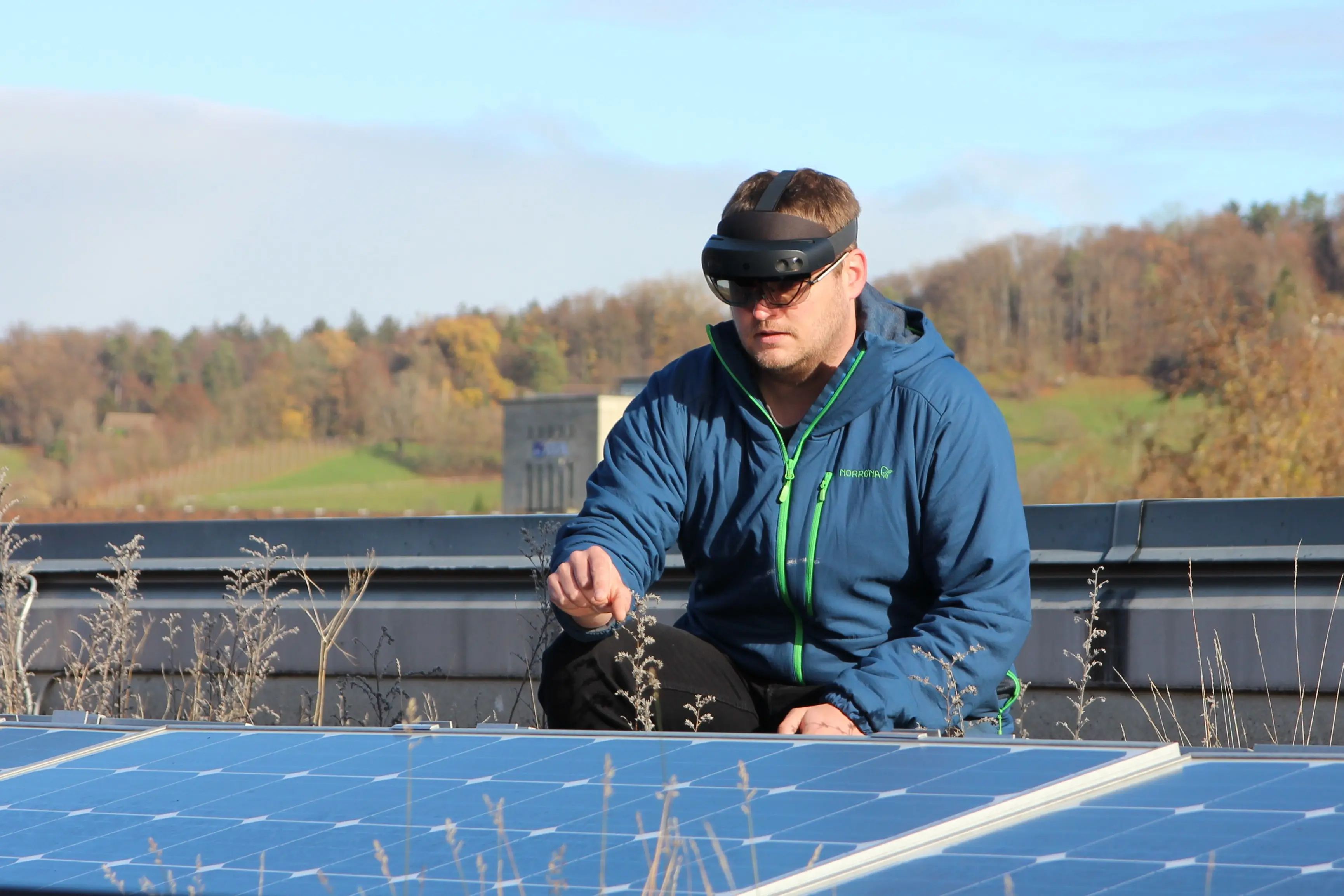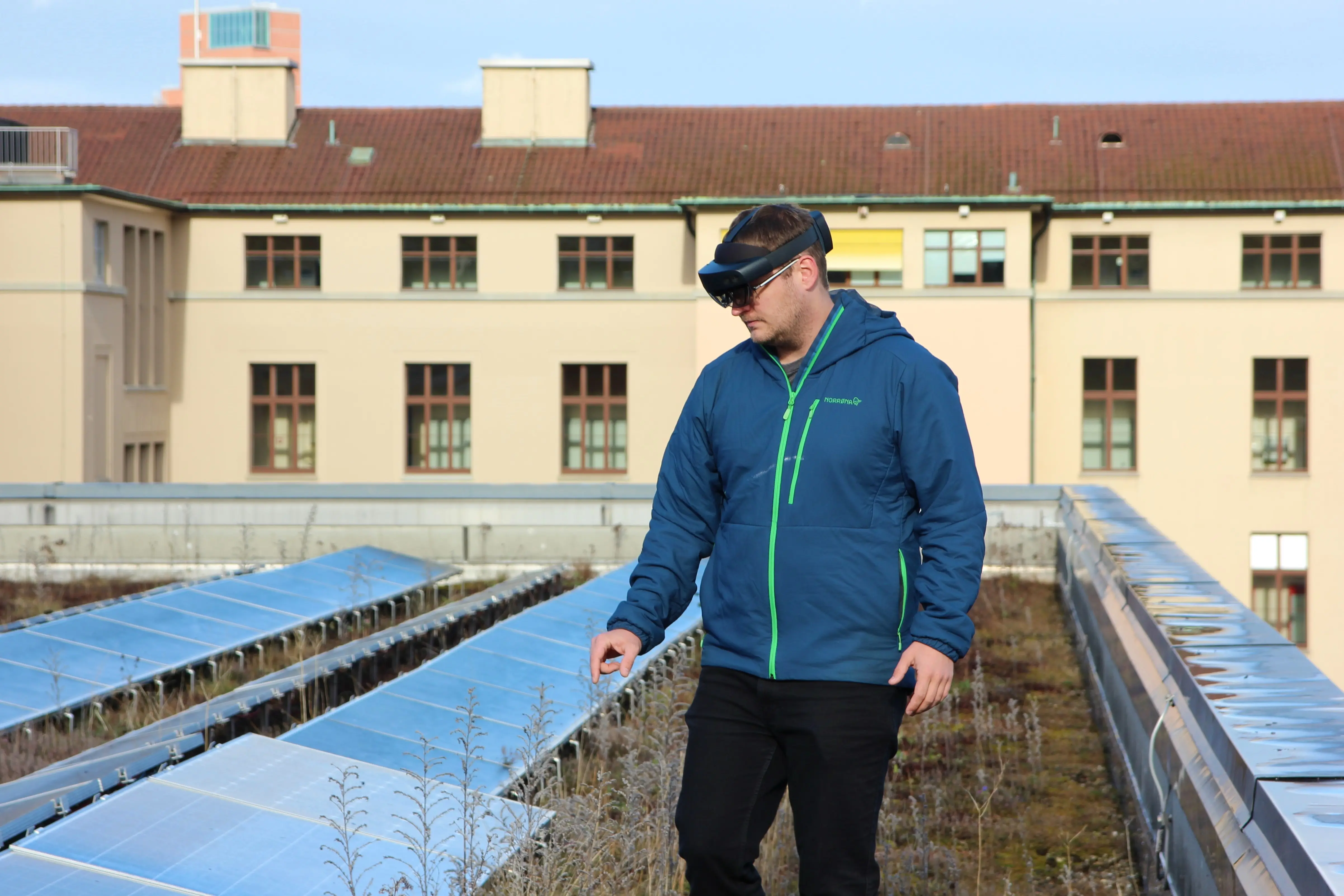New method for planning photovoltaic systems: "This is an easy way to save money"
Today, the planning of small photovoltaic systems is as expensive as the modules themselves. To reduce costs, ZHAW researcher Franz Baumgartner uses a futuristic-looking technology called Augmented Reality.

Measure, plan, install: The way to your own photovoltaic system is sometimes long – and expensive. Franz Baumgartner, head of the Energy and Environmental Engineering degree programme at the ZHAW School of Engineering, is well aware of this. The specialist in photovoltaics says: "In the case of small photovoltaic systems on single-family homes, the modules themselves now account for only a fifth of the costs". Similarly expensive, he says, is now the planning of the system and the documentation required for administrative purposes.
This is precisely where Baumgartner and the ZHAW Institute of Energy Systems and Fluid Engineering (IEFE) in cooperation with the Zühlke company come in. Three years ago, a research colleague of Baumgartner's showed him HoloLens glasses and demonstrated how they are used in the medical field. Baumgartner's first thought: "These must be used in photovoltaics".
How the HoloLens works
The HoloLens are augmented reality glasses from the technology company Microsoft. Augmented Reality, AR for short, means that additional virtual information is projected onto a real environment. The HoloLens enables exactly this. Users fasten it with a headband on their head and fold the visor in front of their eyes. Processors, cameras and projection lenses make the HoloLens an impressive tool.
Information and data are superimposed on the tinted visor through which the user sees the real environment. With finger gestures, the user can give commands and work with the glasses. In the example of photovoltaic systems, it is possible, among other things, to select points on a roof and thus measure distances with an accuracy of about two centimetres.
The glasses do everything at once
Today, various parties are involved in the development of photovoltaic systems. "Up to 15 working hours per system are required for the administrative work," says Baumgartner. Building applications, fire police plans and approvals help to drive up the costs.
"We are striving to make these processes more efficient. In this way it's easier to save money than with cheap modules". Part of the solution could be the HoloLens. Baumgartner says: "In addition to its potential for documenting the entire process, it has a great advantage: it can measure, plan, offer and demonstrate the system to the end customer from a single source".
And this is how it works: To measure the length or width of a roof, the wearer of glasses marks a starting point with a finger gesture, goes to the end point and ends the measurement again with a gesture. In this way he or she can measure the entire roof – even chimneys or parapets that cast disturbing shadows on the modules are quickly detected.
As soon as the user has defined the south direction, determined the orientation and angle of attack and selected the maximum permissible loss due to shadow casting, the HoloLens automatically creates a model of the photovoltaic system. This model can be viewed from all sides in virtual space and can also be adjusted afterwards. End customers can virtually inspect the system – also with the help of the HoloLens.
In the final step, the HoloLens independently calculates the costs of the system and prepares an offer. According to Baumgartner, this should not be the end of the story: "Our goal is to be able to directly trigger an order with all the necessary components. To achieve this, he must first introduce his application to possible partner companies – this type of photovoltaic planning is also new territory for them.
If anywhere, then in Switzerland
Even though the HoloLens is still an expensive purchase today, Baumgartner believes his system will reduce costs. "Thanks to the HoloLens, specialists can get involved exactly where they are really needed". This would relieve the customers' financial burden. Baumgartner says: "Because of the high wages, the system will pay off first in Switzerland".
The involved
The Institute of Energy Systems and Fluid Engineering is working on Franz Baumgartner's SolAR project for the ZHAW. A number of student projects and in particular the collaboration of Fabian Carigiet and Philipp Staiger have played a major role in the development of the project to date. Baumgartner is also in exchange with the Zühlke company. As a service provider for innovation projects, Zühlke already has experience with augmented reality.
Together with ThyssenKrupp, Zühlke has already developed a system for illustrating and quoting stair lifts. This shows that planning with augmented reality is not limited to solar installations. Baumgartner says: "The same methodology can also be applied to the dimensioning and planning of pipelines or kitchens". One would have to use the technology in different areas and: "If this succeeds, Augmented Reality will change engineering".
But first of all, smaller steps are needed. Baumgartner wants to extend its application to all types of flat roofs and to covered car parks. "We are in the process of formulating a project proposal for the Swiss Federal Office of Energy and have already received positive signals from Bern."

